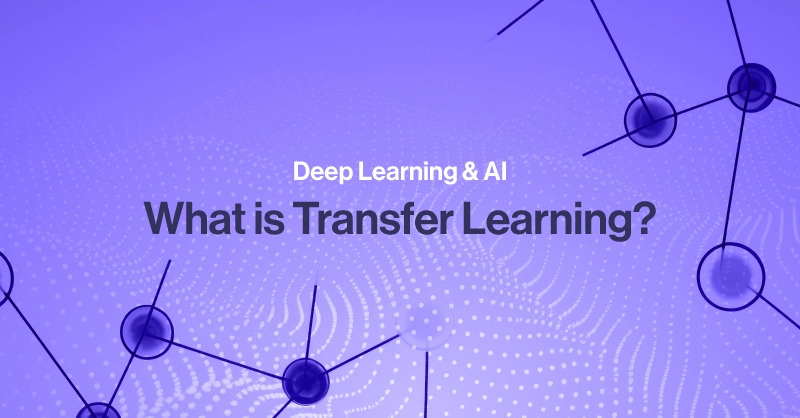Introduction
Training an AI model from scratch takes time, data, and computing power. Transfer learning offers a way to reduce time and data requirements. For example, image classification models pre-trained on ImageNet can quickly adapt to specialized medical imaging tasks.
It uses knowledge from a model trained on one task to solve a different but related task. This method is becoming common in areas like computer vision and natural language processing, where large pre-trained models set the foundation for faster, more accurate results.
What is Transfer Learning?
Transfer learning is a machine learning approach where a model trained on one task is adapted to perform another task. The original model has already learned patterns, features, and relationships from a large dataset. Those learned elements are then applied to the new task, which often has less data available. Often, some layers of the original model are frozen while others are retrained, allowing the model to retain general knowledge while learning task-specific details.
Think of it as applying prior knowledge to a new challenge. A person who speaks Italian can learn Spanish more quickly because many of the grammar rules and vocabulary are familiar. In AI, this reuse of knowledge speeds up development and improves accuracy, especially when the starting data is limited.
Key elements of transfer learning:
- Source task – the original problem the model was trained to solve
- Target task – the new problem to be addressed
- Knowledge transfer – the process of applying what was learned in the source task to the target task
When to Use Transfer Learning
Transfer learning works best when building a model from scratch is impractical or unnecessary. It is especially valuable when the new task has a small dataset but is related to a task with a large dataset already used for training. For example, using BERT pre-trained on general text enables rapid development of a sentiment analysis model with limited labeled data.
Common scenarios include:
- Limited labeled data for the target task
- A need to reduce training time and resource costs
- Access to high-quality pre-trained models in the same domain
- Projects where rapid experimentation is important
It is widely applied in computer vision, natural language processing, and speech recognition. In each case, starting with a pre-trained model can lead to faster results with fewer resources. Keep in mind, if the source and target tasks are very different, transfer learning can actually reduce performance.
Why Transfer Learning Matters
Transfer learning shortens the path from concept to working model. Training large models from scratch can take weeks and demand expensive hardware. By starting with a pre-trained model, the training process becomes faster and less resource-intensive.
It is particularly useful when working with small datasets, where training from scratch would lead to poor performance. Pre-trained models already understand broad features, allowing them to adapt well to new but related problems. This approach can produce higher accuracy and better generalization in less time.
For smaller teams and organizations, transfer learning makes advanced AI development more accessible. It lowers the barrier to entry by reducing both the data and compute requirements needed to achieve strong results. Smaller teams can achieve results similar to larger organizations by starting with pre-trained models.
Related AI Techniques that Use Transfer Learning
Several approaches in AI apply transfer learning principles to adapt pre-trained models for new tasks. The method chosen often depends on the amount of data available, the similarity between the source and target tasks, and the desired performance.
Common techniques include:
- Fine-tuning: Retraining the entire model on the new dataset so it adjusts to the target task.
- Feature extraction: Using the model’s learned representations as input for a new model without retraining all layers.
- Domain adaptation: Adjusting a model to work with data from a different but related distribution.
- Few-shot and zero-shot learning: Training models to make predictions with very few examples (few-shot) or no examples (zero-shot) of a particular class by leveraging knowledge from pre-trained models.
Examples of popular pre-trained models that make use of transfer learning:
- BERT for natural language processing tasks
- ResNet for image classification and detection
- GPT for text generation and understanding
- CLIP for connecting images with text-based descriptions
Conclusion
Transfer learning allows AI models to reuse knowledge from one task to perform another, often with less data and training time. It has become a standard approach in areas like computer vision, language processing, and speech recognition, where large pre-trained models provide a strong foundation.
Reducing costs and improving accuracy, it helps teams move from idea to deployment more quickly. For many modern AI projects, transfer learning is not just a convenience but a practical necessity. As AI models grow in size and complexity, transfer learning will continue to be a key strategy for making advanced AI development accessible and practical.
Looking for a GPU workstation to power a local AI model? Does your business need multiple GPU compute servers to model on company data? Contact SabrePC today for a free quote on any system, workstation, server, or full rack cluster. We serve anybody, from enthusiasts all the way to research institutions and EDU.


